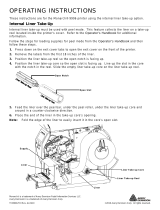
i
TABLE OF CONTENTS
INTRODUCTION...................................................................................................................................... 1-1
Using This Manual.............................................................................................................................. 1-1
Audience ........................................................................................................................................... 1-1
Using the Display and Buttons............................................................................................................. 1-2
Selecting an Option......................................................................................................................... 1-3
Exiting an Option ............................................................................................................................ 1-3
Printing ............................................................................................................................................. 1-3
Selecting a Language ......................................................................................................................... 1-4
SETTING UP THE PRINTER ..................................................................................................................... 2-1
Printer............................................................................................................................................... 2-2
Contrast......................................................................................................................................... 2-2
Ribbon........................................................................................................................................... 2-2
Adjusting the Supply Position........................................................................................................... 2-3
Adjusting the Print Position.............................................................................................................. 2-3
Setting the Margin Adjust................................................................................................................. 2-4
Enabling the Demand Sensor ........................................................................................................... 2-4
Setting the Stock Sensor ................................................................................................................. 2-5
Enabling a sensor.......................................................................................................................... 2-5
Over/Back ......................................................................................................................................... 2-5
Overfeed........................................................................................................................................ 2-6
Backfeed........................................................................................................................................ 2-6
Display.............................................................................................................................................. 2-7
Contrast......................................................................................................................................... 2-7
Backlight........................................................................................................................................ 2-7
Power Management ............................................................................................................................ 2-7
Low Power (Sleep Mode) ................................................................................................................. 2-7
Shut Down ..................................................................................................................................... 2-8
Serial Port......................................................................................................................................... 2-8
Baud Rate...................................................................................................................................... 2-9
Data Bits........................................................................................................................................ 2-9
Parity............................................................................................................................................. 2-9
Stop Bits........................................................................................................................................ 2-9
Flow Control..................................................................................................................................2-10
USB Mode ........................................................................................................................................2-10
Network............................................................................................................................................2-10
Bluetooth® .......................................................................................................................................2-10
Defaults ........................................................................................................................................2-10
Changing the Communication Settings .............................................................................................2-10






















